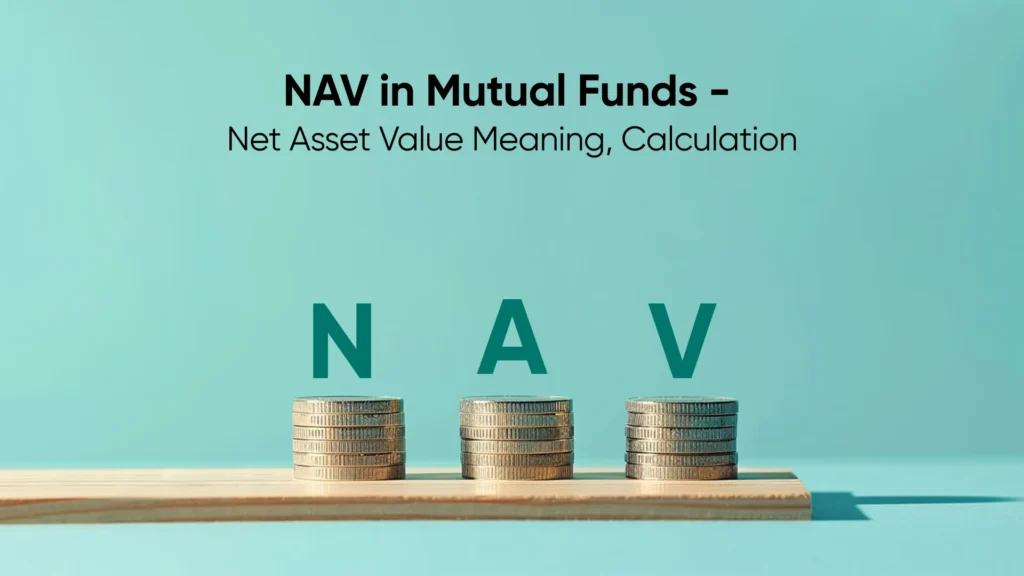NAV in Mutual Funds - Net Asset Value Meaning, Calculation

If you are investing in mutual funds, one key factor to understand is the Net Asset Value (NAV) NAV is a metric that evaluates the performance of a mutual fund and determines the value of your investment. However,investors often misinterpret its significance.
This blog aims to break down NAV, its calculation, and its importance. We also explore factors that influence NAV, compare it to market price, and address common myths to help you make more informed decisions with your investments
Table of Contents
ToggleWhat is NAV in Mutual Funds?
NAV or Net Asset Value of a mutual fund is the price of a single unit of a mutual fund. It is calculated by subtracting liabilities from the total asset value divided by number of shares.
NAV helps the investor determine which investment to withdraw, keep or invest more into. It represents the price at which the investor buys or sells the units of the fund.
As per Securities and Exchange Board of India (SEBI) mandate, the NAV of mutual fund schemes are updated and published daily at the end of the business day.
Importance of NAV in Mutual Fund Investments
For an investor, NAV (Net Asset Value) helps them track the fund’s growth and the returns earned over a period of time.
Performance: It also gives the investor an idea about the fund’s performance. The investor can also understand the fund manager’s strategy and impact on the performance of underlying assets.
Buying and Selling: The investor can keep track of a mutual fund and determine when to buy or sell a fund. For instance, if a fund’s NAV has consistently increased over time, it may indicate it has been performing well. Hence, consider buying more units.
Valuation of Investments: The NAV provides transparency to the investor by allowing them to keep track of funds’ performance over time.
Also Read: Things to Know About Loans Against Mutual Funds
How is NAV Calculated?
To calculate NAV, use this formula:
NAV = (Total assets – Total liabilities) / Total Shares
Let us assume we have invested in an NFO (New Fund Offering) of a mutual fund scheme, and we need to calculate the returns generated. The NAV is Rs. 20. After 4 months, the NAV may have increased to 30.5. Thus, the mutual fund scheme has generated 52.5% returns
Returns = [(30.50 – 20)/20 *100] = 52.5%
Factors Affecting NAV Calculation
The factors affecting NAV calculation includes
Market Value Asset: The NAV of the mutual fund is affected when the market value of investments changes.
Expense Ratio: When an investor invests in a fund, they employ the services of a fund manager through the fund company. The cost of this service is debited from the invested money regularly as fees. This ratio is expressed as a percentage of the fund value. The expense is debited from the fund daily and impacts on the NAV.
Expenses and Liabilities: Expenses like management fees, administrative costs, payable amounts are deducted from the assets while calculating the NAV. If the expenses and liabilities are higher, it can lower the NAV.
Dividends and Distribution When the mutual fund scheme distributes dividends or capital gain to their investors, the NAV lowers. For instance, when a fund pays out dividends, the NAV lowers by the amount distributed.
Fund Inflows and Outflows: When an investor buys shares in a fund, it increases the fund’s assets, thereby increasing the NAV and vice versa. Thus, it is important to track cash flow to understand how they impact the NAV.
NAV vs Market Price: What’s the Difference?
The difference between NAV and market price is when they are calculated. Considering key factors involved, we have differentiated in the below table:
| Factor | NAV (Net Asset Value) | Market Price |
| Definition | Net asset value (NAV) is the value of an investment fund that is determined by subtracting its liabilities from its assets. | Market price refers to the amount of money an asset can be sold in a market. |
| Calculation | NAV = (Assets – Liabilities) / Total Shares | Market price = Selling price + Discount
|
| Represents | It represents the per-unit value of the fund’s assets after deducting any liabilities. | It represents the price at which a product or a service is bought or sold in the market. |
| Updated | NAV is updated once daily, usually at the end of the business day. | The market price is a function of demand and supply. It is constantly changing. |
Impact of NAV on Mutual Fund Returns
The net asset value (NAV) of a mutual fund plays a crucial role in determining the mutual fund returns for an investor. Key factors that impact mutual fund returns:
- Investment Growth: The NAV increases over time reflecting the appreciation of the fund’s underlying assets. This leads to capital gains for investors. For example, if an investor purchases units at a lower NAV and sells when the NAV rises, they earn a profit.
- Dividends and Distributions: When a mutual fund pays out dividends, the NAV may decrease by the amount distributed. For example, if the fund gives out dividends, the NAV will drop by that amount. However, investors gain cash while still having the chance for their remaining NAV to grow.
- Market Conditions: NAVs are impacted by market fluctuations. Economic factors, interest rates, and market sentiment can cause the NAV to rise or fall, which directly impacts the returns an investor receives.
- Timing of Investment: At what time does an investor, sell or buy units affect the returns. Investors who purchase units when the NAV is low can maximize their gains if the NAV rises over time.
Also Read: What is Mutual Fund Return and how to Calculate it?
How Often is NAV Updated?
The NAV (Net Asset Value) is updated and published daily at the end of the day. The value of mutual funds constantly fluctuates due to daily fluctuations in prices of the securities held in the portfolio.
Publishing Time: SEBI (Securities and Exchange Board of India) has mandated mutual funds to update the NAV by 9PM every day.
Availability: Investors can check the updated NAVs on Association of Mutual Funds in India (AMFI) website and other financial news platforms. Additionally, Investors can also access the NAVs through mobile applications and online brokerage platforms.
Holidays and Weekends: On weekends and public holidays, NAVs are not updated, since the stock markets are closed. For instance, if a fund’s NAV is calculated on a Friday, it will remain the same until the next business day (usually Monday).
Examples of NAV Calculation
NAV per unit is the market value of securities of a scheme divided by the total number of units of the scheme on a given date.
Example: Suppose the total market value of the securities held by a mutual fund scheme is ₹300 lakh. The mutual fund has issued 15 lakh units to investors.
NAV Calculation:
To calculate the NAV per unit, you would use the formula:
NAV per unit = Total Market Value of Securities / Total Units Issued
NAV per unit = 300 lakh /15 lakh = ₹20
Thus, the NAV of the mutual fund scheme would be ₹20. This indicates that each unit if the fund is valued at ₹20 based on the current market value of its securities.
Common Misconceptions About NAV
Myth 1: Higher NAV Means Better Performance
A common misconception is that Mutual Funds with higher NAVs are better performers. However, factors like the fund’s historical returns, investment strategy and management quality are more reliable indicators. Thus, a fund’s NAV is not a performance metric and gives only a snapshot of its current worth.
Myth 2: Misunderstanding Negative NAV In Mutual Funds
Many have a misconception that if the mutual funds value lowers, it can become negative.
For instance, if the NAV drops from ₹40 to ₹30, which is a 25% drop. However, NAV is never negative (like -₹10 or -₹20) and is always a positive number.
Myth 3: NAV Determines Investment Value
The NAV is often mistaken as the only indicator of a Mutual Fund’s investment value. However, investment value is also determined by capital gains and dividends. For instance, if you invest in a mutual fund with an NAV of ₹100 for 10 units, your total investment is ₹1,000. If the NAV rises to ₹120 and the fund pays a ₹10 dividend per unit, your total value is ₹1,300 (₹1,200 from NAV and ₹100 from dividends), showing the total value is higher than the NAV alone.
Also Read: Direct vs Regular Mutual Funds: Which is Better for You?
Conclusion
NAV (Net Asset Value) is important to understand how one’s fund is performing. Investors can easily evaluate the value of the investment, the fund strategy, risk and overall management. Understanding how to calculate the value of NAV of a fund will help you make investment decisions and manage your funds accordingly. While NAV is one key aspect of a mutual fund, it is also important to take into account other factors like market conditions, fund type, tax implications, and so forth. Be clear about your financial goals, seek professional guidance, and do your own research before taking investment decisions.
Frequently Asked Questions
What Is The Formula For Calculating NAV?
The formula for NAV calculation is NAV = (Total Assets – Total Liabilities)/ Total Shares
What Does NAV Mean In Mutual Funds?
NAV means Net Asset Value in mutual funds. It is the price at which the investor buys or sells mutual fund units of their investment.
What Affects The NAV Of A Mutual Fund?
Factors that affect the NAV of a Mutual Fund include market fluctuations, dividends & interest, expenses and fees.
What Is The New Rule On Applicable NAV?
As per a new rule, effective February 1st, 2021, the NAV is based on the day the fund house receives the fund and not on the time of transaction.
How Is The Applicable NAV Determined?
Applicable NAV is determined by whether transaction time and payment receipt are done before or after the cut-off time.
What Causes The NAV of A Mutual Fund To Increase?
The NAV of a mutual fund increases due to appreciation of fund assets like equity, debt, and so forth.
Is High NAV Good or Bad?
High NAV is neither good nor bad. NAV is the per unit value of the fund. It is an indicator of the price of the NAV and not a performance indicator. For instance: Consider two funds. One has a NAV of ₹20, and the other has a NAV of ₹200. You invest ₹2,000 in both.
In the fund with a ₹20 NAV, you get 100 units.
In the fund with a ₹200 NAV, you get 10 units.
If both funds grow by 10%, your investment in both increases to ₹2,200. The number of units you own doesn’t matter. The investments grow by the same percentage, so the returns earned are the same.
YOU MAY ALSO LIKE

Search by posts
Recent post
-
 समान मासिक किस्त: आपकी वित्तीय खर्चों को आसान बनाने वाला तरीका
समान मासिक किस्त: आपकी वित्तीय खर्चों को आसान बनाने वाला तरीका
-
 Apply for 50000 Rupees Loan Urgently: Get Disbursed in Few Minutes
Apply for 50000 Rupees Loan Urgently: Get Disbursed in Few Minutes
-
 How to get Instant Loan on Aadhaar Card without Salary Slip
How to get Instant Loan on Aadhaar Card without Salary Slip
-
 How to Apply for a Rs. 25,000 Loan on an Aadhaar Card?
How to Apply for a Rs. 25,000 Loan on an Aadhaar Card?
-
 How to Get ₹30,000 loan without income proof: Quick Ways
How to Get ₹30,000 loan without income proof: Quick Ways
Categories
- Blog (6)
- Credit History (36)
- Credit Line (7)
- Festive (4)
- Finance (15)
- Mutual Fund (19)
- Personal Loan (275)
- Tax (8)
- Zype (4)













